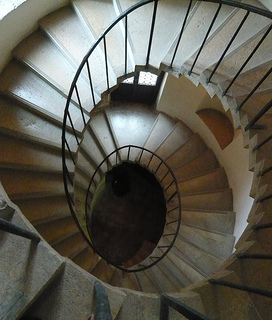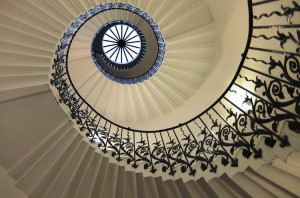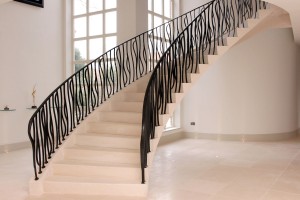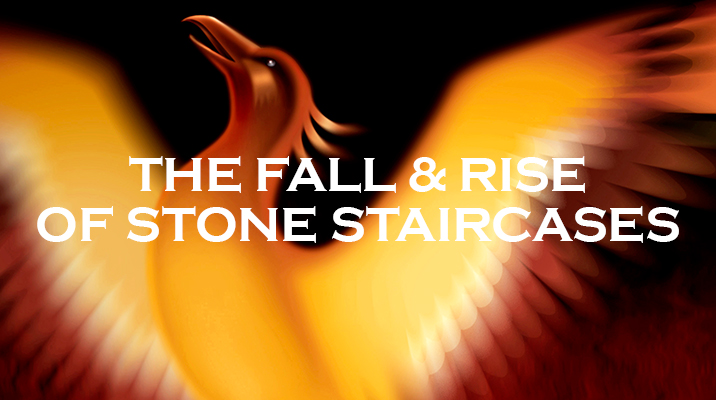Stone staircases through their history have gone through various cycles of design and employment. The first recorded use of the ‘cantilever’ or ‘hanging’ staircase is to be found in the Convento della Caritá, Venice.
In around 1570 the architect Palladio designed and built the staircase, very simple in design and profile, by stacking solid stone treads on top of one another, secured into a wall at one side. The stairs spiralled around the stairwell and allowed a passage of light down the middle of the void.

Convento della Caritá, Venice.
This was noted some fifty odd years later by the English architect Inigo Jones, when visiting Venice. He adopted the technique and designed the famous Tulip Stair in Queens House, Greenwich – the first solid stone ‘cantilever’ staircase in the British Isles, more detailed and elegant than Palladio’s Caritá stair. This set a precedent with visionary architects, including Christopher Wren, soon employing a similar method and stone staircases rising in such places as the Monument and St Paul’s Cathedral. Projects went on to grow in size and scale, with properties such as Hampton Court having a collection of these type of staircases.

Tulip Stairs, Queens House, Greenwhich.
With the unique beauty and characteristics offered by these stairs, their popularity gained momentum. Country houses, grand municipal buildings, Georgian apartments, and London Townhouses all benefitted from their inclusion and continued through the Victorian and Edwardian eras, indeed to the outbreak of the 2nd World War.
It was in the period of reconstruction after the war that the stone staircase seemed to have taken a fall (not literally). Dark days indeed whereby architects, designers and planners seemed more interested in contemporary materials and construction methods, a time that has made its mark in architectural history for all the wrong reasons and the once revered stone staircase largely joining the dole queue.
Perhaps as time went on, and people began to realise that post-war architecture was not our finest hour, the stone staircase was noticed again and in a small way, some visionary souls began to explore their use once again. Maybe the term ‘rebirth’ is a step too far, but the specifying and use of the stone stair has begun to rise since then, and why would it not? The staircases are wonderfully elegant and can accommodate any design. The method is very traditional, but they can be designed and worked to be traditional or contemporary in their appearance. They look gravity defying, are natural, beautiful, environmentally friendly – the list goes on, but all these things were the big attraction to me when over ten years ago, a customer asked me if I could make one and I said yes (gulp!). This took me on a journey to where I am now designing and making stone staircases. A journey where we constantly explore, experiment and review the possibilities. This has allowed to us to not only recreate staircases as they have been undertaken for hundreds of years, but to also develop contemporary methods where we can now construct a solid stone stair without the need for a supporting wall for example.

A contemporary Ian Knapper project in Hampshire, with no supporting wall.
It is now our ceaseless passion to continue this crusade of design and craftsmanship and, just as importantly, spread our mission to those, of which there are many, who may have yet to appreciate and understand the wonders of a natural stone staircase.

